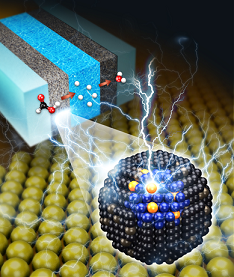
Professor Hyunjoo Lee from the Department of Chemical and Biomolecular Engineering has found a way to reduce the amount of platinum used as catalysts in oxygen reduction reactions. Professor Lee conducted the research along with a team led by Professor Jungwoo Han from the University of Seoul.
Platinum has always been a precious material in synthesizing chemical products, as its malleability and ductility make it easy to handle yet also very unreactive. Platinum is the primary catalyst used in the petroleum industry.
Although not consumed in the reactions themselves, platinum is very expensive. As chemical plants manufacture chemicals on a large scale, the cost of the catalyst plays a vital role in determining the profit of the company.
Single-atom catalysts (SACs) provide an ideal solution for reducing metal usage. SACs are heterogeneous catalysts whose atoms are individually anchored onto a support to stabilize the catalyst. SACs produce a higher yield in chemical synthesis because each atom of the metal, rather than its compound form, is exposed to the reaction. Traditionally, titanium carbide (TiC) has been widely used as the support to anchor the platinum. Current studies on SACs only focus on the anchoring property of the supports and not on the effect of the support on the reaction itself.
The research team managed to reduce the amount of platinum used by 90 percent by using titanium nitride (TiN) as the support for the catalyst. The two single-atom platinum catalysts were prepared and tested in the production of hydrogen peroxide. The titanium nitride showed a production rate 50 times greater than that of a reaction using titanium carbide, as well as enhanced stability.
The discovery of the new support for the single-atom platinum catalyst will open opportunities for platinum to be used in formic acid fuel cells, the power source of modern drones, with higher capacity and stability.
The discoveries were published in Advanced Energy Materials in September. Professor Lee stated, “We hope that the discovery of new forms of the support will contribute to the development of stabilized and affordable acid fuel cells.”

